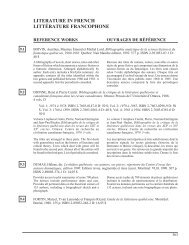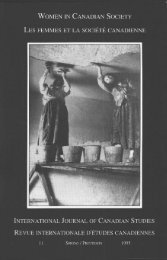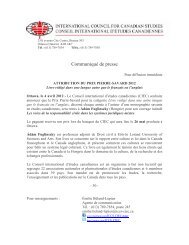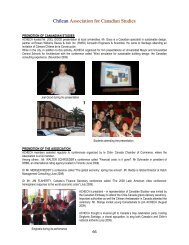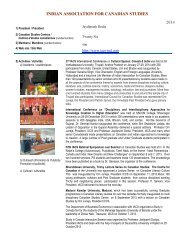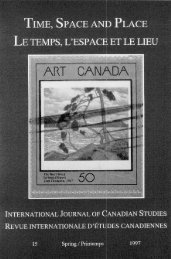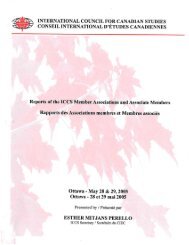Arts and Literature in Canada:Views from Abroad, Les arts et la ...
Arts and Literature in Canada:Views from Abroad, Les arts et la ...
Arts and Literature in Canada:Views from Abroad, Les arts et la ...
- No tags were found...
Create successful ePaper yourself
Turn your PDF publications into a flip-book with our unique Google optimized e-Paper software.
IJCS/RIÉCterms, b<strong>et</strong>ween the po<strong>et</strong> <strong>and</strong> the natural world <strong>in</strong> which he f<strong>in</strong>ds himself. Does he presenthimself directly or create a separate persona for his purpose? Do we look through theprotagonist's eyes or is he presented as himself a part of the l<strong>and</strong>scape? Is the narrator anobserver or a participant? A native or an outsider? A teacher or a learner?” (1980: 9).However, perspective here refers both to the poem's agent of perception <strong>and</strong> its speaker, <strong>and</strong>the term thus <strong>la</strong>cks c<strong>la</strong>rity.5. A notable exception is A<strong>la</strong>n Spiegel's discussion of visual perspectives <strong>in</strong> Fiction <strong>and</strong> theCamera Eye (1976); James A.W. Heffernan (1984) gives an equally <strong>in</strong>spir<strong>in</strong>g treatment ofvisual perspective <strong>in</strong> English Romantic art <strong>and</strong> po<strong>et</strong>ry. For a brief discussion of perspective<strong>in</strong> a visual-spatial sense also cf. Bal (1985: 94).6. An aspect which features prom<strong>in</strong>ently <strong>in</strong> the German discussion of l<strong>and</strong>scape esth<strong>et</strong>ics <strong>in</strong>philosophy, art history <strong>and</strong> literary criticism; for a survey cf. Eckhard Lobsien (1981).7. Cf. Yi-Fu Tuan (1974) on the role of attitude <strong>and</strong> world view <strong>in</strong> a person's re<strong>la</strong>tionship tohis/her environment: “Attitude is primarily a cultural stance, a position one takes vis-à-visthe world. ... World view is conceptualized experience. It is partly personal, <strong>la</strong>rgely social. Itis an attitude or belief system ...” (4).8. Appl<strong>et</strong>on has been justly accused for his neglect of the cultural <strong>and</strong> historical change <strong>in</strong>l<strong>and</strong>scape experience. If prospect <strong>and</strong> refuge are def<strong>in</strong>ed as concepts whose def<strong>in</strong>ition <strong>and</strong>value is culture-specific, their heuristic value is <strong>in</strong>disputable.9. All poems are quoted <strong>from</strong> the editions listed <strong>in</strong> the bibliography.10. For this development also cf. Marjorie Nicolson (1959).11. This may also be c<strong>la</strong>imed for American Romanticism: Tony Tanner (1987) notes a“gravitation towards empty space” (28) that is particu<strong>la</strong>rly strong <strong>in</strong> writers such as Bryant,Emerson, Thoreau or Whitman, although the American man/l<strong>and</strong>scape re<strong>la</strong>tionship differs<strong>in</strong> several traits <strong>from</strong> that of the Europeans.12. “The most important re<strong>la</strong>tional structure is distance, <strong>and</strong> th<strong>in</strong>gs are seen <strong>in</strong> depth with regardto the po<strong>in</strong>t of view, that is to say, as more or less remote <strong>from</strong> the spectator. ... The idea ofperspective can readily be associated with a grow<strong>in</strong>g epistemological dualism, with arigorous split b<strong>et</strong>ween subject <strong>and</strong> object” (Guillén 1971: 293f.)13. This effect contributes to the om<strong>in</strong>ousness <strong>in</strong> many of Emily Carr's forest pa<strong>in</strong>t<strong>in</strong>gs of th<strong>et</strong>wenties (a great number of which are reproduced <strong>in</strong> Shadbolt 1979).14. “The social <strong>in</strong>cludes all l<strong>and</strong>scapes that are conducive to the life of man <strong>in</strong> the community, orthat <strong>in</strong> some way reflect social values. The antisocial consists ma<strong>in</strong>ly of the great primevalwilderness of mounta<strong>in</strong>, sea, <strong>and</strong> forest” (Fl<strong>et</strong>cher 1983: 3).15. The term is used here <strong>in</strong> the sense def<strong>in</strong>ed by Jean Gebser (1949): not as a mere <strong>la</strong>ck, but atransgression of perspective, which Gebser considers characteristic of the modern Westernworld.16. For d<strong>et</strong>ailed discussions of Renaissance perspective <strong>in</strong> art history see, for example, JohnWhite (1957) <strong>and</strong> Mart<strong>in</strong> Kemp (1990).17. See, for example, McGregor (1985: 348-353).18. See, for example, Ernest Redekop (1970) on Avison; Sherill Grace (1980) on Atwood.19. Cf. Miriam Wadd<strong>in</strong>gton's “Green World Two”, Elizab<strong>et</strong>h Brewster's “Where I ComeFrom”, or Gwendolyn MacEwen's “Dark P<strong>in</strong>es Under Water.”20. It evades perspective as a “sign-format” of Western pa<strong>in</strong>t<strong>in</strong>g which, accord<strong>in</strong>g to NormanBryson (1981) <strong>in</strong>duces one to read an image as “realistic” representation rather than as sign.BibliographyI. Primary SourcesAtwood, Margar<strong>et</strong>. “This Is a Photograph of Me.” M<strong>and</strong>el ed., 85Atwood, Margar<strong>et</strong>. The Journals of Susanna Moodie. Toronto: OUP, 1970.Atwood, Margar<strong>et</strong> ed. The New Oxford Book of Canadian Verse <strong>in</strong> English. Toronto: OUP, 1982.Avison, Margar<strong>et</strong>. “Perspective.” Gustafson ed., 219f.Campbell, Wilfred. “The W<strong>in</strong>ter Lakes.” Atwood ed., 40.Carman, Bliss. “Morn<strong>in</strong>g <strong>in</strong> the Hills.” Atwood ed., 45Goldsmith, Oliver. “The Ris<strong>in</strong>g Vil<strong>la</strong>ge.” S<strong>in</strong>c<strong>la</strong>ir ed., 2-14.22



